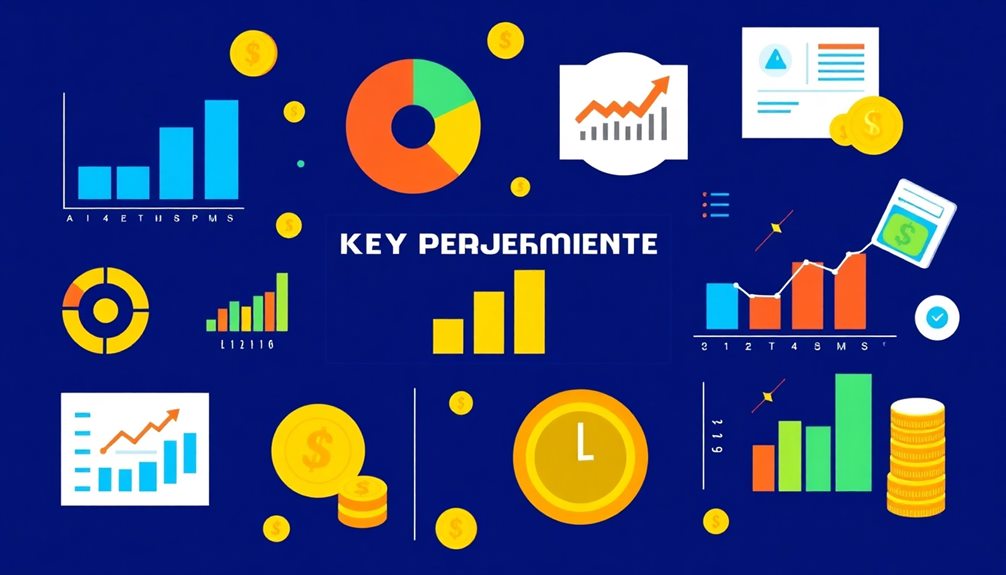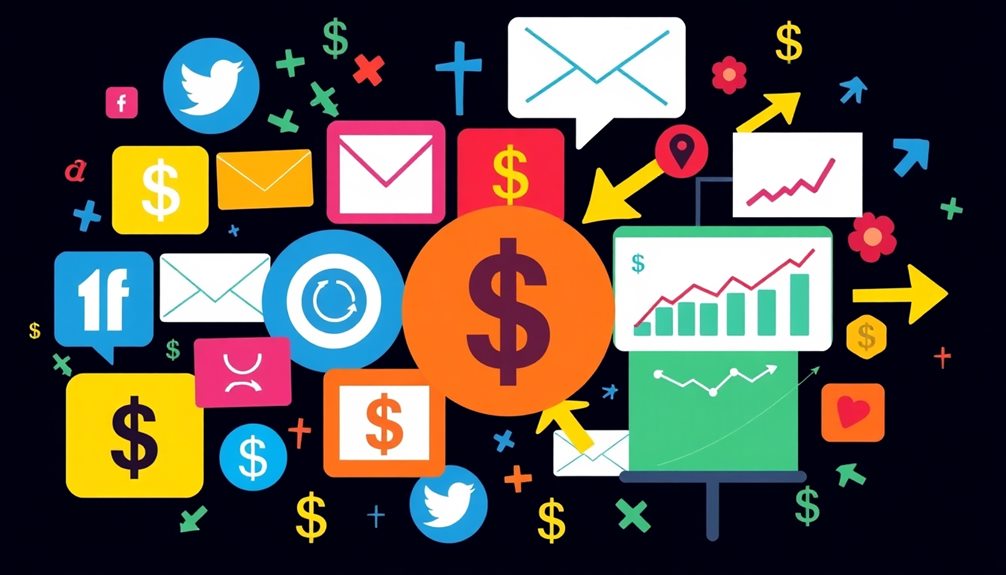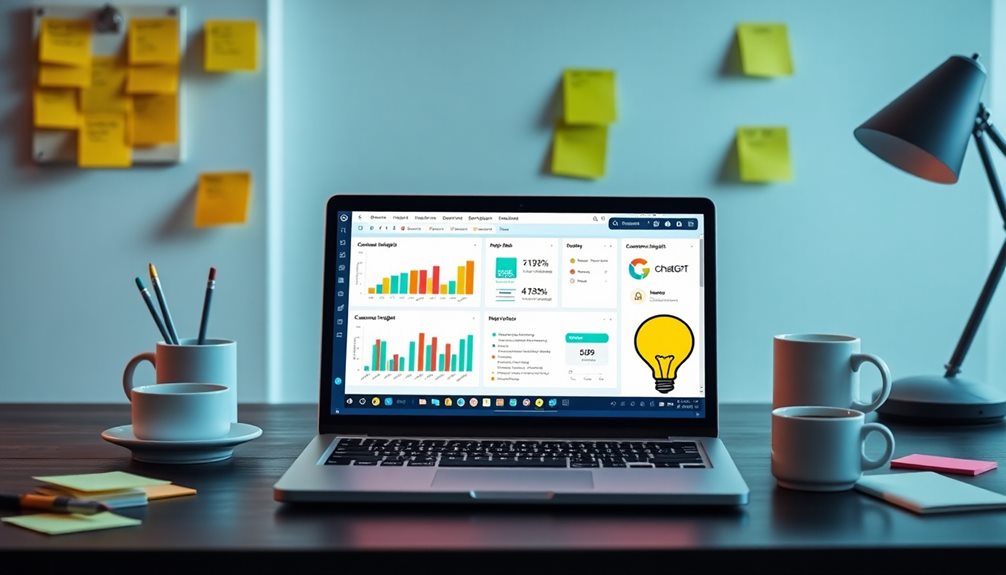Cost efficiency is crucial for your marketing success. It guarantees you get the most out of every dollar spent, helping to maximize results while minimizing waste. By focusing on key metrics like Cost per Acquisition (CPA) and Conversion Rate, you can assess your strategies' effectiveness. Regularly optimizing ad campaigns and exploring different marketing channels can lead to improved ROI. Embracing technology and leveraging customer insights further enhances your ability to connect with audiences. Understanding these principles will not only save you money but will also boost your marketing performance. Discovering more tactics can elevate your efficiency even further.
Key Takeaways
- Marketing efficiency maximizes results while minimizing costs, enhancing return on investment (ROI) for any marketer.
- Key metrics like Cost per Acquisition (CPA) and Marketing Efficiency Ratio (MER) help evaluate spending effectiveness.
- Utilizing data-driven strategies and audience segmentation improves engagement and conversion rates significantly.
- Multi-channel approaches and technology integration streamline efforts, reducing Customer Acquisition Cost (CAC) and boosting campaign effectiveness.
- Continuous assessment and optimization of marketing strategies minimize wasted spend and foster a culture of improvement.
What Is Marketing Efficiency?

Marketing efficiency is essential for any business aiming to maximize its impact without overspending. It centers on optimizing your marketing strategies to achieve the best results while minimizing resource expenditure. By focusing on key metrics like Cost per Acquisition (CPA) and Customer Acquisition Cost (CAC), you can better understand your spending and its effectiveness.
These metrics help you evaluate how much you're investing to gain each customer, which directly influences your return on investment (ROI). Additionally, implementing data-driven decision-making can considerably enhance your marketing efficiency, allowing you to adapt strategies based on performance insights and user feedback, similar to building a business like software.
The Marketing Efficiency Ratio (MER) is another critical metric. It compares total sales revenue against your marketing spend, giving you a clearer picture of how efficiently your marketing dollars are working. When you adopt well-optimized marketing strategies, you can enhance overall campaign effectiveness, ensuring that you achieve greater results with fewer resources.
In challenging economic conditions, maintaining marketing efficiency becomes even more essential. By continuously monitoring and adjusting your strategies based on real-time data, you can identify and eliminate spending leaks, keeping your operations steady and effective, even when budgets are tight.
This approach ultimately allows you to navigate the complexities of the market with confidence.
Measuring Marketing Efficiency

To truly optimize your marketing strategies, you need to measure their efficiency accurately. Start by tracking your Cost Per Acquisition (CPA) and Customer Acquisition Cost (CAC). These metrics reveal how much you're spending to acquire new customers, helping you identify areas for improvement.
Additionally, understanding your budget allows for better allocation of resources in your marketing efforts.
Next, focus on your Click-Through Rate (CTR). This metric shows how well your ads engage potential customers and whether your messaging resonates.
Don't overlook the Conversion Rate, which tracks the percentage of users who complete a purchase after clicking on your ad. A high conversion rate indicates that your marketing efforts effectively drive sales.
Key Performance Indicators

When it comes to measuring your marketing success, defining relevant metrics is essential. You'll want to track KPIs like Cost Per Acquisition and Conversion Rate to understand how well your campaigns perform.
Additionally, understanding how to create a retirement savings plan can provide you with insights into long-term financial stability, which is equally important for sustaining your marketing efforts.
Defining Relevant Metrics
In today's competitive landscape, identifying the right Key Performance Indicators (KPIs) is crucial for marketers looking to maximize their impact. KPIs are measurable values that show how effectively you're achieving business objectives. Metrics like Cost Per Acquisition (CPA) and Customer Acquisition Cost (CAC) are critical for evaluating your marketing efficiency. These figures help you understand how much you're spending to gain each customer, guaranteeing your budget is used wisely.
Another important metric is the Marketing Efficiency Ratio (MER), which evaluates total sales revenue against marketing spend. This insight allows you to gauge the overall effectiveness of your campaigns, highlighting where improvements can be made.
Additionally, tracking your Click-Through Rate (CTR) is essential, as it measures customer engagement with your ads, revealing the effectiveness of your ad copy and targeting strategies.
Don't overlook the Conversion Rate, which tracks the percentage of visitors completing desired actions. This metric helps you understand customer progression in the buying journey, pinpointing areas for enhancement.
Regularly evaluating these KPIs guarantees your marketing strategies are optimized for cost efficiency, ultimately leading to improved Return on Investment (ROI).
Tracking Campaign Performance
Tracking campaign performance through Key Performance Indicators (KPIs) is essential for marketers aiming to refine their strategies and enhance efficiency. By closely monitoring metrics like Customer Acquisition Cost (CAC) and Cost per Acquisition (CPA), you can evaluate the financial viability of your campaigns. Understanding these costs helps you allocate resources more effectively.
Another important KPI is Click-Through Rate (CTR), which measures how well your ads engage potential customers. A high CTR indicates that your messaging resonates with the target audience, while a low CTR signals the need for adjustments.
Additionally, tracking the Conversion Rate is critical; it reveals the percentage of leads that move through your marketing funnel, helping you identify bottlenecks in the buying journey.
Optimizing Ad Campaigns

Optimizing ad campaigns can greatly impact your marketing budget and overall success. By conducting thorough keyword research before launching pay-per-click (PPC) campaigns, you can reduce advertising costs by 20-30%. Targeting the most relevant search terms guarantees you're spending wisely.
During your campaign, analyze mid-campaign metrics to identify underperforming keywords. Making prompt adjustments can potentially boost conversion rates by up to 50%.
Implementing A/B testing for different ad versions, like headlines and images, can also enhance your click-through rates (CTR) by 20-30%. This improves your overall campaign effectiveness while maximizing your investment.
Regularly fine-tuning your ad copy based on performance data can lead to a 10% increase in conversion rates, further refining ad campaigns.
Exploring Different Marketing Channels

After fine-tuning your ad campaigns, exploring different marketing channels can further maximize your marketing efforts. Utilizing a multi-channel strategy can boost customer engagement by 24%, allowing you to reach potential customers through various touchpoints.
By testing different channels—like display ads versus static emails—you'll identify the most effective platforms, enhancing your return on investment (ROI) and reducing customer acquisition costs (CAC).
Social media advertising is particularly potent, offering advanced targeting options that can increase conversion likelihood by 27%. Analyzing performance metrics such as click-through rates (CTR) and conversion rates will help you adapt your strategies based on data-driven insights, greatly improving your overall marketing campaigns.
Furthermore, integrating traditional and digital marketing efforts through an omnichannel approach can elevate customer experience and satisfaction, leading to a remarkable 90% increase in customer retention rates.
By exploring and optimizing various marketing channels, you're not just enhancing your outreach; you're also ensuring that your marketing budget is utilized effectively, maximizing both engagement and profitability.
Embrace these effective strategies, and watch your marketing efforts flourish.
Leveraging Customer Insights

To connect with your audience effectively, you need to tailor your marketing messages based on customer insights.
By segmenting your audience, you can create personalized content that speaks directly to their needs and preferences.
This approach not only boosts engagement but also enhances customer loyalty and satisfaction.
Tailoring Marketing Messages
Understanding your audience is essential for crafting marketing messages that truly resonate. By leveraging customer insights, you can create tailored messages that reduce your customer acquisition cost (CAC) while maximizing your return on investment (ROI).
Here are three strategies to help you refine your marketing messages:
- Surveys and Feedback: Gather insights through surveys to identify customer pain points and preferences. This data allows you to address their needs directly.
- Data Analytics: Utilize analytics to track customer interactions. This information provides valuable insights into what your audience finds engaging, enabling you to create relevant content.
- Personalized Marketing: Implement personalized marketing strategies. Companies that adjust their messaging based on insights see up to ten times the response rate compared to non-personalized efforts.
Segmenting Audience Effectively
Segmenting your audience effectively can transform your marketing strategy, leading to higher engagement and conversion rates. By leveraging audience segmentation based on demographics, behaviors, and preferences, you can create tailored marketing messages that resonate deeply. Targeted campaigns can boost engagement and conversion rates by up to 760%, making your efforts markedly more impactful.
Utilizing customer insights from surveys and feedback helps you identify pain points and specific needs. This enables you to craft personalized content that enhances customer satisfaction and loyalty. Data analytics tools play an essential role here, as they can track customer interactions and preferences, allowing you to segment your audience dynamically. This real-time adjustment makes your marketing strategies more effective.
Moreover, effective audience segmentation leads to more efficient resource allocation. Targeted campaigns generally have a lower customer acquisition cost (CAC), which helps maximize your return on investment (ROI) for marketing efforts.
Regularly updating your audience segments based on new insights guarantees your strategies remain relevant, adapting to changing consumer behaviors and preferences over time. Embrace audience segmentation, and watch your marketing efficiency soar.
Utilizing Technology for Efficiency

While many marketers still grapple with time-consuming tasks, utilizing technology can greatly improve efficiency in your campaigns. Investing in marketing automation tools can save you up to two hours daily by streamlining repetitive tasks.
By integrating these tools with your existing CRM systems, you guarantee seamless data flow, which reduces manual work in lead management and customer interactions.
To further boost your campaign efficiency, consider these strategies:
- Analytics Platforms: Use analytics platforms to track performance metrics in real-time. This can lead to a potential 25% optimization in your paid search campaigns.
- Predictive Analytics: Leverage AI for predictive analytics to gain deeper insights into customer behavior and preferences. This enhances your targeting accuracy and ultimately improves your overall campaign effectiveness.
- Conversation Intelligence Tools: Employ conversation intelligence tools to automatically analyze customer interactions. This provides valuable insights that can refine your marketing strategies and drive better engagement.
Incorporating these technologies not only increases your operational efficiency but also empowers you to make data-driven decisions that can considerably impact your marketing success.
Embracing User-Generated Content

Embracing user-generated content can transform your marketing strategy by tapping into the authentic experiences of your customers.
When you showcase real testimonials, you not only build trust but also foster deeper engagement with your audience.
This approach not only saves you money but also creates a community around your brand, amplifying your reach and impact.
Authentic Content Creation
User-generated content (UGC) has become a game-changer for marketers looking to boost their campaigns without breaking the bank. By tapping into authentic customer experiences, you can enhance your marketing strategies and create a lasting impact on your audience.
Here are three key benefits of embracing UGC:
- Increased Customer Engagement: Brands that incorporate UGC see a 79% boost in customer engagement. By encouraging your customers to share their experiences, you foster a vibrant community around your products.
- Enhanced Brand Trust: UGC greatly impacts purchasing decisions, with 79% of consumers stating it enhances their trust in a brand. When potential customers see real people using your products, they're more likely to feel confident in their buying choices.
- Improved Conversion Rates: Companies utilizing UGC achieve a 4.5% higher conversion rate compared to those relying solely on brand-generated content. This shows that authentic content can effectively drive sales and build loyalty.
Building Trust Through Engagement
Leveraging user-generated content (UGC) is a powerful way to build trust and deepen engagement with your audience. By incorporating UGC into your marketing strategies, you can enhance brand trust considerably. In fact, 79% of consumers say UGC highly influences their purchasing decisions.
When you encourage your customers to share their experiences, you foster community engagement, with 50% of consumers feeling more connected to brands that do so. Not only does UGC create authentic content that resonates strongly with your audience, but it also leads to a notable 20% increase in return visitors.
People appreciate real stories over traditional advertising; 70% of millennials trust content created by their peers more than conventional ads. This shift underscores the importance of UGC in your marketing approach.
Additionally, embracing UGC can reduce your content creation costs since 79% of individuals believe it reflects a brand's quality. By tapping into the creativity of your audience, you can cultivate a loyal community that champions your brand and drives sales.
Continuous Improvement Strategies

In the fast-paced world of marketing, continuously tracking campaign performance against set KPIs is vital for identifying areas that need improvement. By implementing continuous improvement strategies, you can optimize your marketing budget and guarantee a higher return on investment (ROI).
Here are three key actions to take:
- Regularly review and adjust: Allocate time to assess your budget and campaign performance. This helps you spot inefficiencies and reallocate resources to strategies yielding better results.
- Foster a culture of testing and learning: Encourage your team to experiment with different approaches. This mindset not only sparks innovation but also leads to refined tactics over time.
- Utilize data analytics tools: Leverage these tools for real-time insights into your campaigns. Adjust your strategies based on performance metrics to enhance relevance and engagement.
Engaging in ongoing customer feedback assessments is also essential. This allows you to refine your campaigns continuously, driving better engagement and conversion rates.
Additional Resources for Marketers

Many marketers find themselves searching for effective resources to enhance their strategies and optimize budgets. Accessing resources that focus on optimizing digital advertising budgets can dramatically reduce wasted spend.
For instance, subscribing to the Invoca Blog can provide you with ongoing insights into marketing efficiency and cost-effective strategies, keeping you updated on the latest trends in conversation intelligence.
Utilizing call tracking technology is another powerful tool that can help you attribute conversions from calls to specific marketing efforts. This approach can potentially optimize your paid search campaigns by up to 25%.
Additionally, exploring guides on minimizing wasted marketing spend equips you with actionable strategies to achieve better results with fewer resources.
Engaging with thought leadership content from industry experts through curated articles enhances your marketing knowledge and informs your decision-making process.
Regular reviewing and adjusting based on these insights can improve your overall cost efficiency. By leveraging these additional resources, you can identify potential customers more effectively and refine your marketing strategies for maximum impact.
Frequently Asked Questions
Why Is Cost Efficiency Important?
Cost efficiency's important because it helps you maximize your resources. By ensuring every dollar counts, you boost your financial stability, enhance operational effectiveness, and position yourself for greater success in achieving your marketing goals.
What Is Cost Efficiency in Marketing?
Cost efficiency in marketing means you achieve your goals while minimizing expenses. You focus on maximizing returns and optimizing processes, like automating tasks, to guarantee every dollar spent generates value and drives success for your campaigns.
Why Is Efficiency Important in Marketing?
Efficiency in marketing's essential because it maximizes your resources, boosts ROI, and lowers customer acquisition costs. By focusing on targeted strategies, you can improve engagement and adapt quickly to market changes for sustained success.
Why Is Cost Important in Marketing?
Cost's important in marketing because it directly affects your return on investment. By managing expenses wisely, you maximize your impact, ensuring every dollar helps achieve your goals, driving growth and sustainability for your business.
Conclusion
In today's competitive landscape, cost efficiency isn't just a luxury—it's a necessity for every marketer. You might think cutting costs means sacrificing quality, but that's far from the truth. By measuring your marketing efficiency and optimizing campaigns, you can achieve better results without breaking the bank. Embrace technology and user-generated content to enhance your strategies. Remember, continuous improvement is key. With the right approach, you can boost your effectiveness and keep your budget in check.










